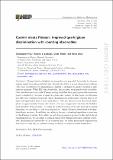Casimir meets Poisson: improved quark/gluon discrimination with counting observables
Author(s)
Frye, Christopher; Larkoski, Andrew J; Zhou, Kevin; Thaler, Jesse
Download13130_2017_Article_6675.pdf (1.357Mb)
PUBLISHER_CC
Publisher with Creative Commons License
Creative Commons Attribution
Terms of use
Metadata
Show full item recordAbstract
Charged track multiplicity is among the most powerful observables for discriminating quark- from gluon-initiated jets. Despite its utility, it is not infrared and collinear (IRC) safe, so perturbative calculations are limited to studying the energy evolution of multiplicity moments. While IRC-safe observables, like jet mass, are perturbatively calculable, their distributions often exhibit Casimir scaling, such that their quark/gluon discrimination power is limited by the ratio of quark to gluon color factors. In this paper, we introduce new IRC-safe counting observables whose discrimination performance exceeds that of jet mass and approaches that of track multiplicity. The key observation is that track multiplicity is approximately Poisson distributed, with more suppressed tails than the Sudakov peak structure from jet mass. By using an iterated version of the soft drop jet grooming algorithm, we can define a “soft drop multiplicity” which is Poisson distributed at leading-logarithmic accuracy. In addition, we calculate the next-to-leading-logarithmic corrections to this Poisson structure. If we allow the soft drop groomer to proceed to the end of the jet branching history, we can define a collinear-unsafe (but still infrared-safe) counting observable. Exploiting the universality of the collinear limit, we define generalized fragmentation functions to study the perturbative energy evolution of collinear-unsafe multiplicity.
Date issued
2017-09Department
Massachusetts Institute of Technology. Center for Theoretical Physics; Massachusetts Institute of Technology. Center for Theoretical PhysicsJournal
Journal of High Energy Physics
Publisher
Springer Berlin Heidelberg
Citation
Frye, Christopher et al. "Casimir meets Poisson: improved quark/gluon discrimination with counting observables." Journal of High Energy Physics 2017 (September 2017): 83 © 2017 The Author(s)
Version: Final published version
ISSN
1029-8479
1126-6708